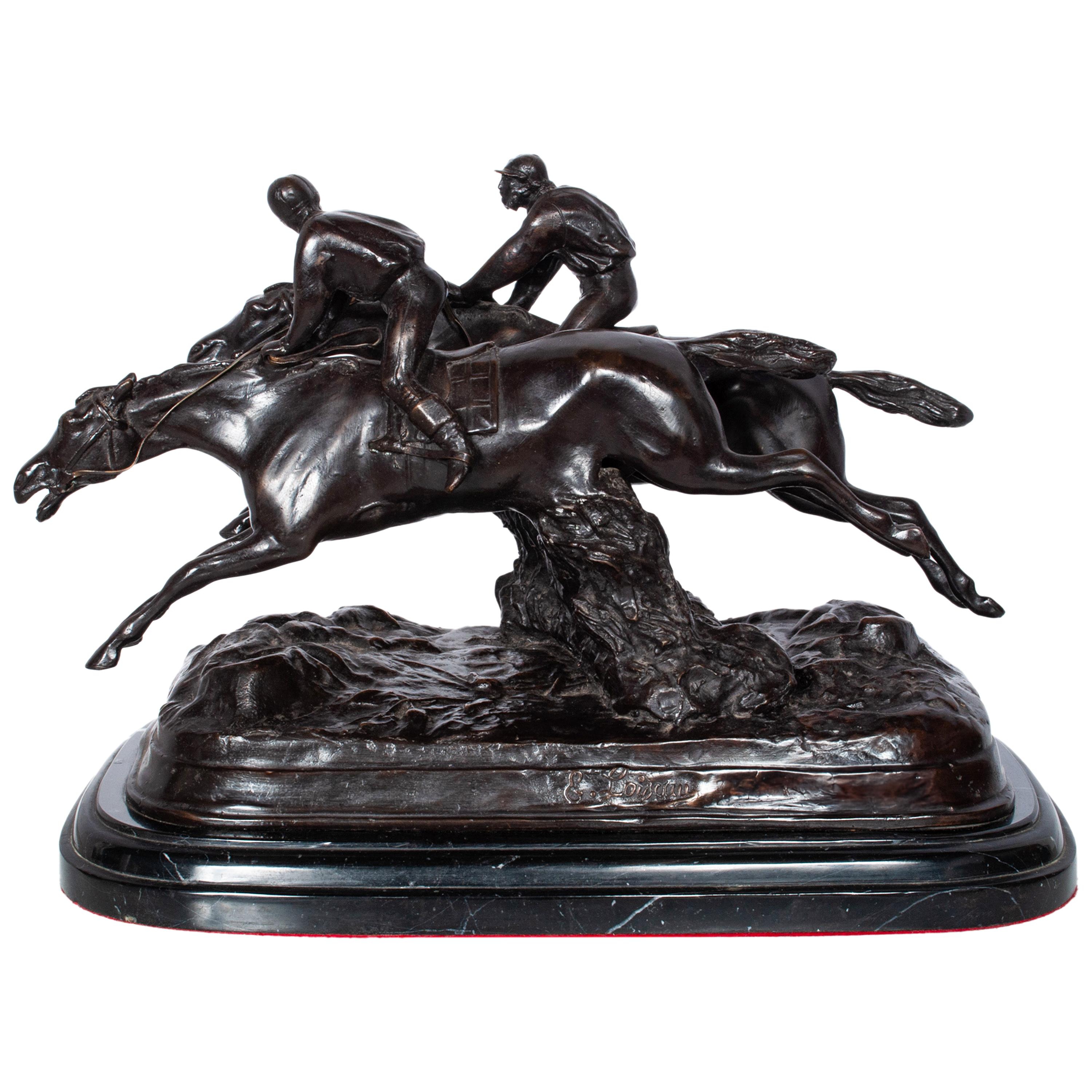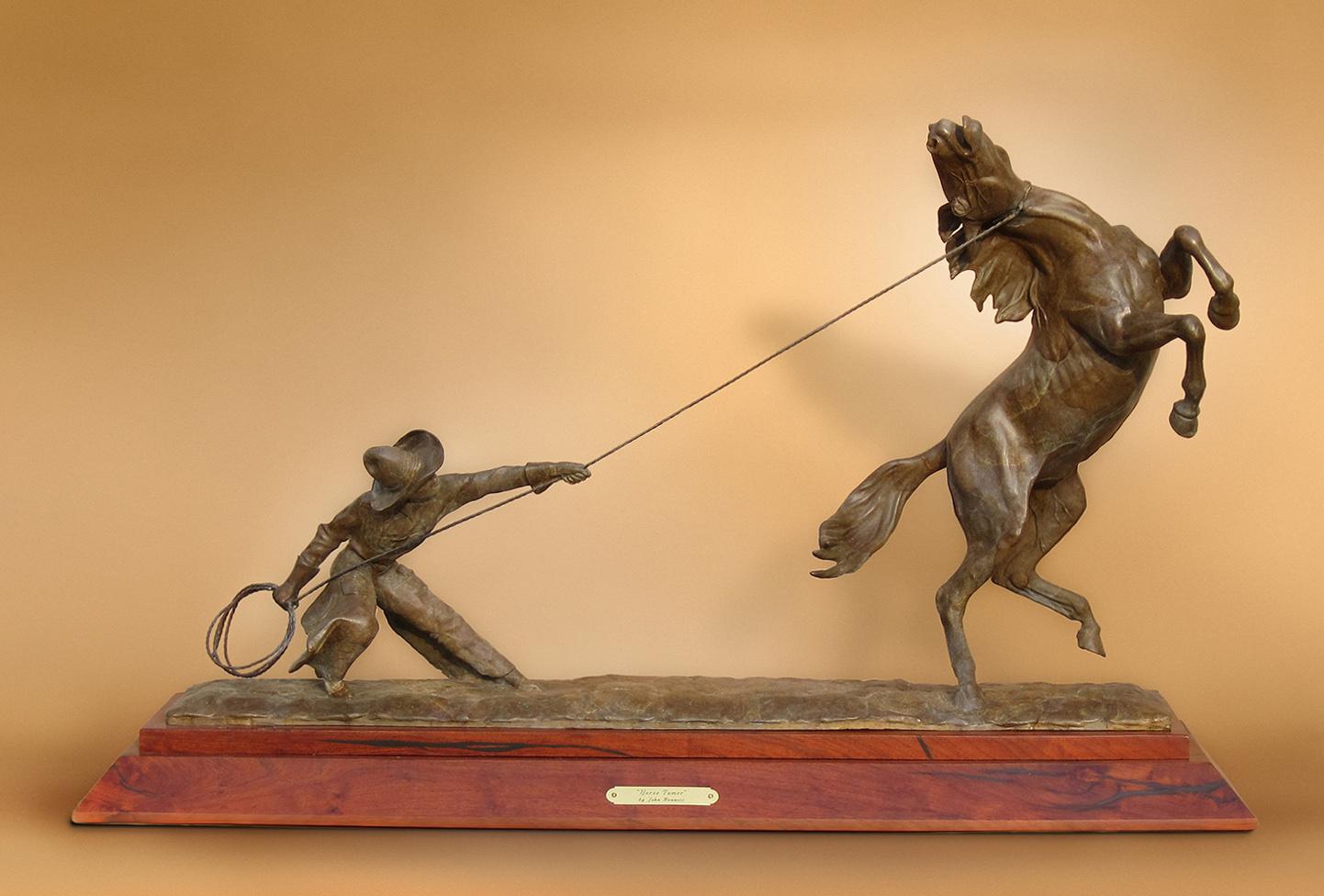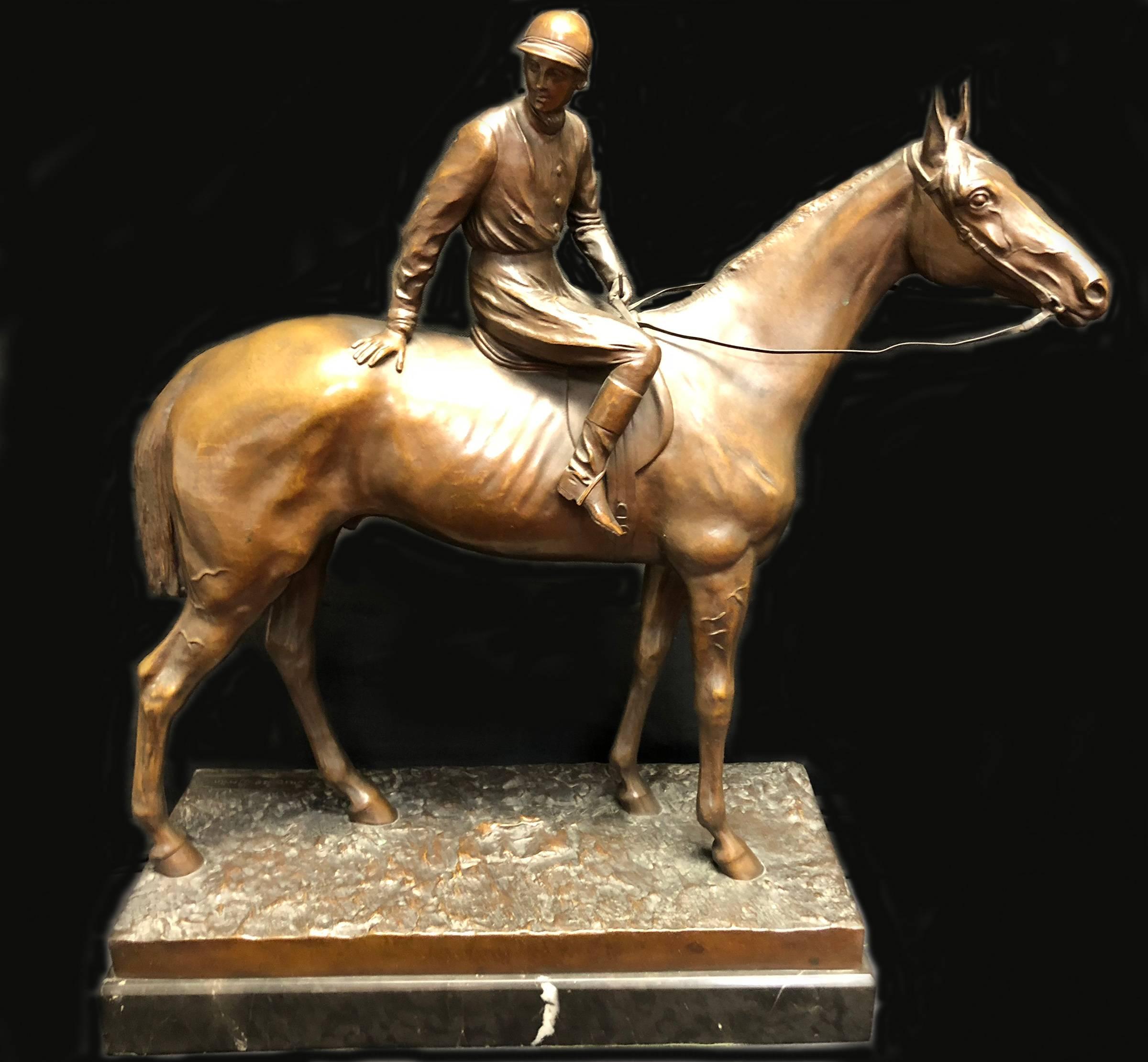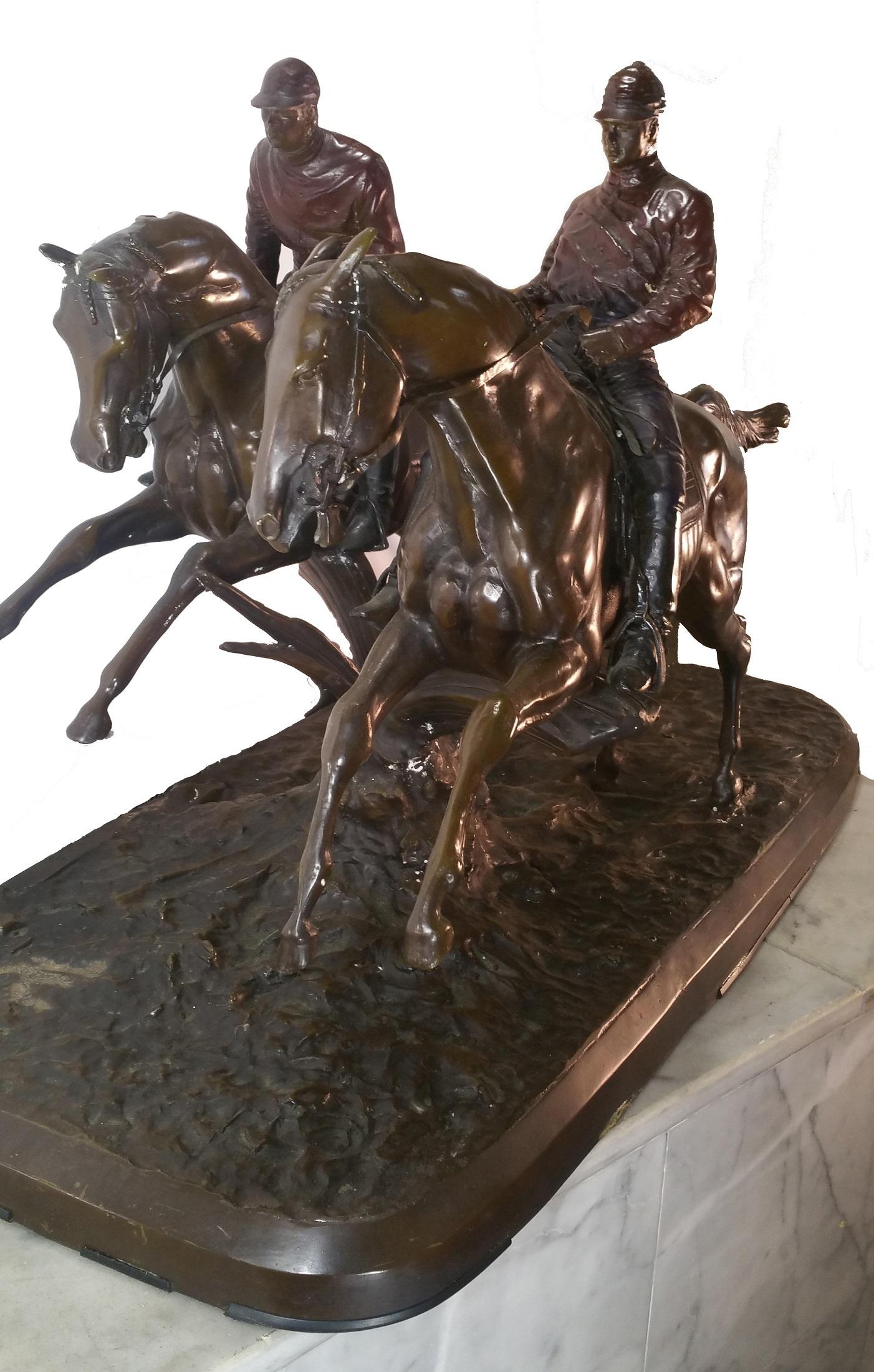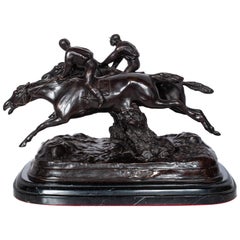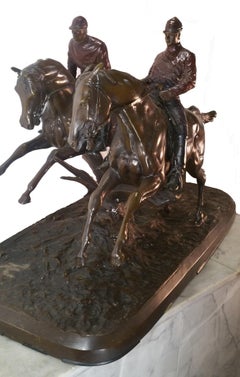Items Similar to Horse training with its stable lad
Want more images or videos?
Request additional images or videos from the seller
1 of 10
Horse training with its stable ladcirca 1896
circa 1896
$93,111.18
£70,131.25
€79,000
CA$128,404.32
A$144,256.50
CHF 75,374.25
MX$1,760,718.12
NOK 957,032.76
SEK 900,844.73
DKK 601,317.97
About the Item
(after) Arthur Marie Gabriel comte du Passage (1838-1909)
Horse training with its stable lad
A rare large bronze group with nuanced dark brown patina
circa 1896
signed on the base "C du Passage"
Period cast
height 81 cm
length 110 cm
depth 44 cm
Reward for the Regional Contest of Moulins in 1896 as it is mentionned to the front of the base : "Ministère de l’Agriculture / Concours Régional Hippique de Moulins / 1896 / Prix d’Honneur".
Bibliography : Pierre Kjellberg, Les bronzes du XIXème siècle, dictionnaire des sculpteurs, les Editions de l'Amateur, 2005, modèle reproduit page 560.
Biography :
Arthur Marie Gabriel comte du Passage (1838-1909) was a French animal sculptor. He began a military career and at the same time practiced sculpture with illustrious masters such as Antoine-Louis Barye and Pierre-Jules Mêne. While serving as a second lieutenant at Maubeuge, he exhibited at the Salon in 1865. He also produced sports drawings published in newspapers of the time. However, at this time of his life he saw all of this as just artistic training and did not consider leaving the military career for art.
It was in 1862 that a heavy fall from his horse permanently handicapped the count and he had to quit the profession of arms. If he had the greatest difficulty walking, he could still ride a horse and thus followed the many hunts. He also befriended Henri de Toulouse-Lautrec. The sculptor worked in his studio at the Château de Bernaville in Frohen, and regularly sent his works to the Salon of the French Artists. One of the most famous works of the Comte du Passage is this "Horse in training with his lad".
- Creation Year:circa 1896
- Dimensions:Height: 31.89 in (81 cm)Width: 43.31 in (110 cm)Depth: 17.33 in (44 cm)
- Medium:
- Movement & Style:
- After:Comte du Passage (1838 - 1909, French)
- Period:
- Condition:
- Gallery Location:PARIS, FR
- Reference Number:Seller: N.77621stDibs: LU2514213591902

About the Seller
5.0
Recognized Seller
These prestigious sellers are industry leaders and represent the highest echelon for item quality and design.
Established in 1992
1stDibs seller since 2023
8 sales on 1stDibs
Typical response time: 20 hours
- ShippingRetrieving quote...Shipping from: PARIS, France
- Return Policy
Authenticity Guarantee
In the unlikely event there’s an issue with an item’s authenticity, contact us within 1 year for a full refund. DetailsMoney-Back Guarantee
If your item is not as described, is damaged in transit, or does not arrive, contact us within 7 days for a full refund. Details24-Hour Cancellation
You have a 24-hour grace period in which to reconsider your purchase, with no questions asked.Vetted Professional Sellers
Our world-class sellers must adhere to strict standards for service and quality, maintaining the integrity of our listings.Price-Match Guarantee
If you find that a seller listed the same item for a lower price elsewhere, we’ll match it.Trusted Global Delivery
Our best-in-class carrier network provides specialized shipping options worldwide, including custom delivery.More From This Seller
View AllHorse training with its stable lad
Located in PARIS, FR
Horse training with its stable lad
by Arthur Marie Gabriel comte du Passage (1838-1909)
A bronze group with nuanced dark brown patina
Signed on the base " Cte du Passage "
Period ca...
Category
Late 19th Century French School Figurative Sculptures
Materials
Bronze
Jockey Winner
By Isidore Jules Bonheur
Located in PARIS, FR
Jockey Winner
by Isidore BONHEUR (1827-1901)
A rare and magnificent bronze group with a dark brown patina
Signed on the base "I. Bonheur"
A period cast by "Peyrol" (with the foundry stamp)
Standing on a molded wooden base
France
circa 1880
height of the bronze : 53,5 cm
total height with the base : 62 cm
total length : 68 cm
depth : 24 cm
Biography:
Isidore Jules Bonheur (1827-1901) was a French painter and sculptor. Isidore first received an artistic apprenticeship from his father Raymond and his older sister Rosa, then, in 1827, he entered the School of Fine Arts in Paris. After practicing...
Category
1880s French School Figurative Sculptures
Materials
Bronze
Turkish Horse
By Antoine-Louis Barye
Located in PARIS, FR
Turkish Horse
by Antoine-Louis Barye (1796-1875)
"Cheval turc, antérieur gauche levé, terrasse carrée"
Bronze sculpture with a nuanced dark brown patina
Signed " Barye " on the base...
Category
Late 19th Century French School Figurative Sculptures
Materials
Bronze
Turkish Horse
By Antoine-Louis Barye
Located in PARIS, FR
Turkish Horse
by Antoine-Louis BARYE (1796-1875)
"Cheval turc, antérieur gauche levé, terrasse carrée"
Bronze with a nuanced dark green patina
signed "Barye" on the base
cast by "F....
Category
1880s French School Figurative Sculptures
Materials
Bronze
Tartar warrior stopping his horse
By Antoine-Louis Barye
Located in PARIS, FR
Tartar warrior stopping his horse
by Antoine-louis BARYE (1796-1875)
Equestrian group in bronze with a nuanced dark greenish brown patina
any cast mark
old edition cast
France
cir...
Category
Late 19th Century French School Figurative Sculptures
Materials
Bronze
Turkish Horse
By Antoine-Louis Barye
Located in PARIS, FR
"Turkish Horse"
by Antoine-Louis Barye (1796-1875)
Bronze with nuanced dark brown patina
cast by BARBEDIENNE
France
circa 1880
height 28 cm
length 31,5 cm
This is the biggest size...
Category
1880s French School Figurative Sculptures
Materials
Bronze
You May Also Like
Antique French 19th Bronze Equestrian Group Horses Jockeys Statue Sculpture 1895
Located in Portland, OR
A fine late 19th century antique French bronze sculpture group, of a pair of race horses & jockeys, by Paul Louis Emile Loiseau-Rousseau, Paris (1861-1927).
The bronze circa 1895 de...
Category
1890s French School Figurative Sculptures
Materials
Bronze
"HORSE TAMER" BRONZE SCULPTURE
Located in San Antonio, TX
John Bennett
(Born 1952)
Fredericksburg, Texas Artist
Image Size: 22 x 37 across x 10
Medium: Bronze
"Horse Tamer"
John Bennett (Born 1952)
John Bennett was designated Texas State Ar...
Category
20th Century Modern Figurative Sculptures
Materials
Bronze
Jockey On Horseback
By Hans Guradze
Located in Missouri, MO
Hans Guradze (German, 1861-1922)
"Jockey On Horseback"
Bronze
Approx. 19.5 x 17 x 6 inches
Signed "H. Guradze Berlin" on Base
Category
1890s Realist Figurative Sculptures
Materials
Bronze
Price Upon Request
Mounted Jockeys Taking a Jump
Located in Saratoga Springs, NY
Bronze (After) Henri (Comte) Geoffroy De Ruille, Mounted Jockeys (French 1842-1922)
"Mounted Jockeys Taking a Jump"
40"long x 26" high x 20 ½" wide
20th Century
Medium: Patinaed B...
Category
Mid-20th Century Academic Figurative Sculptures
Materials
Bronze
Unknown sculptor. Large sculpture in the shape of a horse on a plinth.
Located in København, Copenhagen
Pre-owned goods are exempt from import duties for U.S. customers.
Therefore, no import tariffs will be applicable to your purchase.
Unknown sculptor. Large sculpture in the shape o...
Category
20th Century Unknown Animal Sculptures
Materials
Metal
Mare - hunting horse by Josuë Dupon 1864-1935
Located in Gent, VOV
A beautiful large bronze sculpture of a proud standing mare. Old sand cast created during the artist Josuë Dupon's lifetime.
Josuë Dupon (also Josué or Josue Dupon) was a Flemish sculptor and engraver. His work also includes painting and graphics.
He received his training through evening classes at the academy of Roeselare and Antwerp (1884) and later at the National Institute of Fine Arts (1887). In 1891, he won a gold medal with the monumental sculpture group Samson kills the lion and was runner-up in the Prix de Rome for sculpture. From that year on, his work appeared regularly in exhibitions at home and abroad. His reputation was such, that he became one of a select group of sculptors allowed by King Leopold II to carve statues in Ivory, which was imported from the Congo, the Belgian colony. In 1893 his exceptionally refined ivory statue of Diana was bought by the Antwerp Royal Museum of Fine Arts, which also acquired his spectacular bronze Vulture defending its prey a year later.
Working in every genre and mastering every technique and material, Josuë Dupon became best known as a sculptor of exotic animals. He was equally capable of faithfully expressing anatomical detail as of rendering the animals' nature. Josuë Dupon was a technically faultless realist, with a sense of the dramatic, a feeling for decorative complexity and a tendency towards idealizing. The placement of his camel driver and two bronze groups at the entrance to Antwerp Zoo confirmed this reputation as animalier.
The career that Dupon subsequently built, brought him numerous important awards and an appointment as professor at the Antwerp Academy, a tenure he held between 1905 and 1934. Besides animals, he sculpted busts, war memorials and public monuments. For one of the largest sculptural monuments and the largest fountain in the city of Buenos Aires, called Monument of the Two Congresses, he collaborated with his good friend, the Belgian sculptor Jules Lagae. Josuë Dupon created several statues of mighty condors for this monument.
At the start of his career his conception of art was strongly influenced by traditional 19th century artistic ideals. After the turn of the century his compositions and surface treatment changed and became more modern. He met Rembrandt Bugatti around 1905 or 1906 in the 'Jardin des Plantes' in Paris and invited him to Antwerp. Bugatti began travelling to Antwerp in 1906 to observe and sculpt the inhabitants of its zoo, which was then considered the best in the world, and Dupon allowed Bugatti to stay with him during several of his early visits. As such Dupon became a friend and a bit of a father figure to Rembrandt Bugatti.
Dupon did not play a very active part in artistic movements or associations. Dupon remains an important sculptor not only through his body of work but also because of the influence he exercised through interactions and collaboration with other sculptors such as Lagae, Bugatti and Bourdelle but also because he trained leading sculptors such as Albéric Collin (1886-1962), Willy Kreitz...
Category
19th Century Figurative Sculptures
Materials
Bronze
More Ways To Browse
Antique Stable
Stable Sign
Antique Horse Sculptures
French Horse Sculpture
Large Horse Sculptures
Military Horse
Horse Sculptures Of 19th Century
Cast Bronze Horse
19th Century Bronze Horse Sculpture
Large Bronze Horse Sculpture
Antoine Louis Barye
Pierre Jules Mene Bronze
Pierre Jules Mene Bronze Sculpture
Moulin Sculptures
560 Gold
Mene Horse
Mene Bronze Horse
Pierre Jules Mene Bronze Horse
